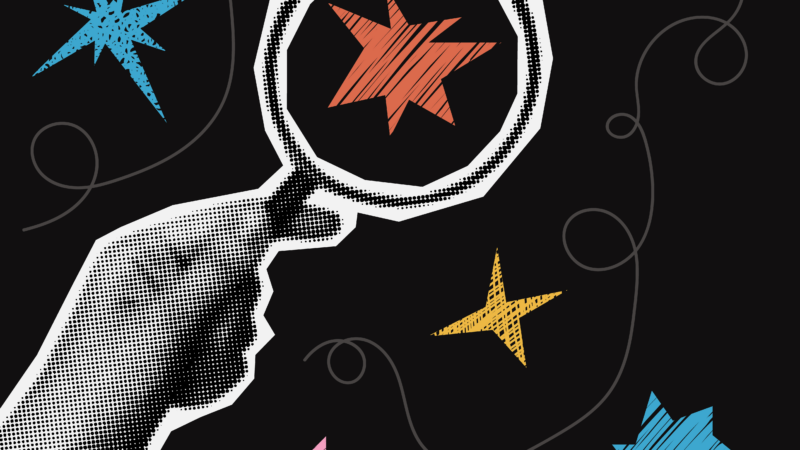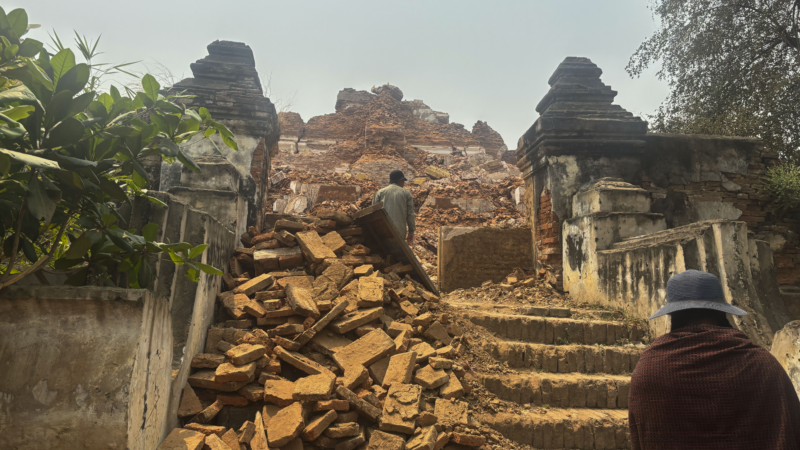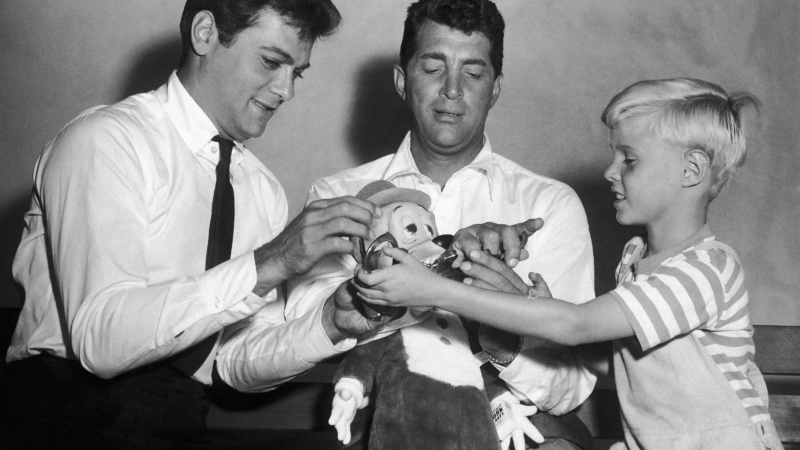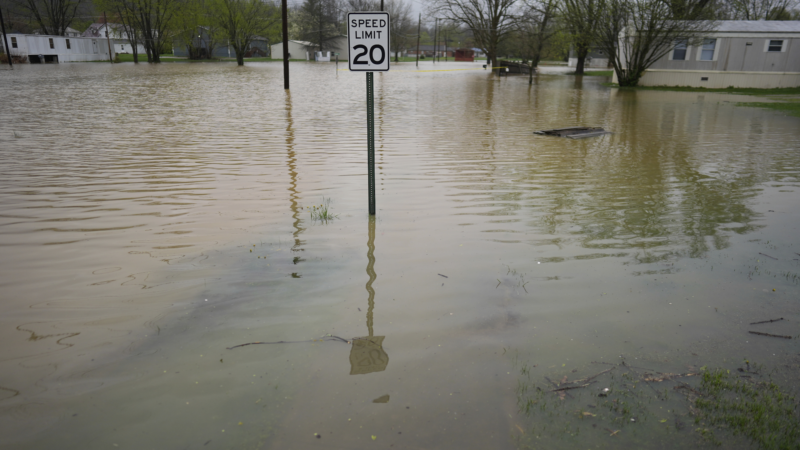How to quickly find something you lost: 10 clever and practical techniques
When I published my episode on how to find lost objects in November, people messaged me with all kinds of useful techniques to hunt down missing items.
So many of you told me to pray to St. Anthony, the patron saint of lost objects — a tip that my grandma has sworn by since I was a kid. Others had some very practical advice: Look in coat pockets, lay a flashlight on the floor (if you’ve lost a tiny object, the beam may cast a large shadow) and — here’s a good one — make sure you know what it looks like!
Here’s a roundup of advice from our audience on how to look for stuff — plus a few bonus tips from our experts. We hope this helps you quickly find whatever you’re searching for. These responses have been edited for length and clarity.
For science-backed and expert-recommended techniques to find missing objects, listen to the podcast episode above, or read the original story here.
What to do if you’ve lost a wallet
Look up your last credit card transaction, and then go to the place where you last spent the money and look around there. —Darryl Ellis, a private investigator and the head of A-1 Detective Agency in Illinois
Watch things fall as you drop them
I have trained myself to watch things fall when I drop them. If you watch a small screw fall and see where it lands and bounces, you will have no trouble finding it. If you just look at the place where the screw was supposed to go and growl and curse, expect to have trouble finding it. —Gregory Vogt
Don’t ever put it in a “special place”
The worst possible thing to do is to place something of value in a “special place” that is “easy to remember” for “safekeeping.” Ha! Definitely not recommended. —Shan Crockett
Use a flashlight
I find a flashlight to be a useful search aid, day or night. The beam forces me to focus on a limited area. It helps me see, instead of just looking. Held near the floor, it makes things shine.
A girlfriend once lost her contact outdoors, in a driveway, with snow on the ground. I waited until after dark and then quickly found the contact in a snow pile at the edge of the street. —Art Clack
Start cleaning
My mother taught me this tip: When you cannot find something, clean up and you will find it. I often find the item when I’m picking up something to put it back in its proper place. —Anne Chevalier
Check favorite hangout spots
Go to the places you hang out most and look there first. Do you have a favorite place you sit on the sofa? Look through the cushions and under and behind the sofa. Do you hang out on the patio? Look in between seats and chairs or on tables outdoors.
My youngest son is autistic and nonverbal. He wears glasses and sometimes comes up to me without them on his face. To look for them, I always go to his favorite places around my home. They might be in his bed, his sensory swing or the closet. I always end up finding them. —Naeemah Ford Goldson, executive director and founder, National Association of Black Professional Organizers
Make a mental note of something you’re likely to lose
I make a mental note when I put something down — like my keys, glasses or phone — in a place I do not usually put it. It is akin to underlining or highlighting something in writing to help make it easier to remember. —Marc R. Inver
Come back to it
Take a break from looking for your missing object and relax or do something else. Without worrying and fussing, your brain will quietly surprise you with a stored memory that will suddenly pop into your consciousness and lead you to the missing object. —Gregory Vogt
Look carefully in the most obvious place
Look in the most likely place it should be. Most of the time, it’s there. You just overlooked it. —Kelly Connolly
Make sure you know what it looks like
Numerous times, my wife has sent me to get something in the basement, and I can’t find it at first because she told me the wrong color, container or location. Make sure you know the correct characteristics, or you may easily overlook what you are looking for. —John Heinen
The digital story was edited by Meghan Keane. The visual editor is Beck Harlan. We’d love to hear from you. Leave us a voicemail at 202-216-9823, or email us at LifeKit@npr.org.
Listen to Life Kit on Apple Podcasts and Spotify, and sign up for our newsletter. Follow us on Instagram: @nprlifekit.
Transcript:
MARIELLE SEGARRA, HOST:
You’re listening to LIFE KIT…
(SOUNDBITE OF MUSIC)
SEGARRA: …From NPR.
(SOUNDBITE OF MUSIC)
SEGARRA: Hey, everybody. It’s Marielle. A few years ago, our digital editor, Malaka Gharib, lost her passport two days before a big international trip. Getting a new passport expedited would cost her hundreds of dollars, and she wasn’t sure if it would even get to her in time.
MALAKA GHARIB, BYLINE: You can imagine how stressed I was. I mean, the last time I saw my passport was on the bed, but I retraced my steps about a dozen times and nothing.
SEGARRA: She was so stressed about the missing passport, she even took off work to look for it.
GHARIB: I mean, I was really frazzled. I tore up the house, and I was checking the most random places, like the bathroom cabinets.
SEGARRA: That experience made Malaka think, you know, there has to be a more methodical way of finding lost objects.
GHARIB: Right. I mean, like, what do researchers know? And what about people like detectives and search-and-rescue responders? How do they hunt stuff down?
SEGARRA: On this episode of LIFE KIT…
(SOUNDBITE OF MUSIC)
SEGARRA: …How to find the stuff you’ve lost. And we’re not just going to tell you to look harder if you’ve lost something. Malaka will bring you useful techniques to find things that don’t have an AirTag on them, whether that’s something sentimental like a class ring or something valuable like an envelope full of cash or something you need to cross the border.
GHARIB: And I’ll reveal how I finally found my missing passport.
(SOUNDBITE OF MUSIC)
GHARIB: So after I called my boss and told them I wasn’t coming in, I went into my bedroom, where I lost my passport, and I turned it upside down. I remember feeling so overwhelmed that I wasn’t looking carefully enough. That’s exactly what you want to avoid when you’re looking for a lost object. This is takeaway one. Your attention is like a spotlight, and you need to be able to point it at the task at hand. To do that, you’ve got to relax, which, I know, is the last thing you want to hear when you’ve lost something important.
Arryn Robbins is a cognitive psychologist at the University of Richmond, and she specializes in visual search. She says that stress clouds our ability to focus.
ARRYN ROBBINS: Stress can have a couple of different types of effects on us. So imagine you’re highly distracted because you’re thinking about something that’s coming up.
GHARIB: Like a big international trip that you’re packing and getting ready for.
ROBBINS: That type of distraction, that mental distraction is taking away attentional resources from the task at hand.
GHARIB: So I was already frazzled when I was handling my passport to begin with. Then I realized I lost it, which was my second layer of stress.
ROBBINS: In terms of visual processing, when you are stressed out, you have that sort of fight-or-flight response kicking in. That sympathetic nervous system is kicking into gear. Your heart is beating a little faster. You might get a little sweaty because you’re anxious. What that does is it actually narrows your attention.
GHARIB: So, if your attention is like a spotlight, you could increase the size of that beam or shrink it down. When it’s narrow, it’s almost like you’re having tunnel vision. On one hand, that can be great. You’re able to process your environment with a lot more detail.
ROBBINS: But you, to some degree, need your attention sort of expanded in order to get the gist of your search environment to know where to put that spotlight next.
GHARIB: So take a moment to widen that beam.
(SOUNDBITE OF MUSIC)
ROBBINS: It helps to take a breath, kind of calm the body down because it really is your body response to that stress that’s causing that restriction in attention.
GHARIB: Once you’ve calmed down and centered yourself again, it’s time to start hunting. Takeaway two, if you’ve lost something important, think about the features of the object that would really make it stand out in the environment. Arryn says it’ll make your search easier and more efficient.
ROBBINS: When you are looking for objects, you’re using a bunch of different cognitive processes in your brain, but the two most important ones are memory and attention.
GHARIB: You’re going to rely on your memory to remind you of what the lost object looks like and its likely location.
ROBBINS: Its visual features like color, shape, texture, size, memory for where the object is most likely going to be, and that information in memory is used to direct your attention.
GHARIB: Say you’re looking for a white sedan in the parking lot. To find it, you’re not going to look at every single car in the lot.
ROBBINS: Your attention is going to be directed to cars that are white, that are sedan-shaped. You’re going to skip over the black SUVs, and that helps you save time.
GHARIB: This is what scientists call attentional guidance. It’s the process of moving your attention toward areas in your environment where you’d most likely find your object, including important features of your object and where you tend to keep the object. It’s something we do all the time without even realizing it, when we look for a toothbrush in the morning or a favorite coffee mug. You only realize you’re looking for something when it becomes challenging – for example, when you’re looking for a white sedan in a parking lot full of white sedans.
ROBBINS: So in that case, you have to really think about what would make this object stand apart in the scene? What are some distinctive features of this object? Maybe you have a bumper sticker that sets it apart.
GHARIB: Arryn used this tactic recently when she lost the back of a rose gold earring on a carpet in a similar color.
(SOUNDBITE OF MUSIC)
ROBBINS: So I had to think about, OK, what would set my earring apart from this carpet that would allow me to find it? Well, my earring is shiny. It would reflect light. And so, as soon as I thought about that, like, almost instantly, I saw it.
(SOUNDBITE OF MUSIC)
GHARIB: OK. So you’ve tried this technique, and you still can’t find what you’re looking for. Time for takeaway three – think about the likely scenarios of how and where your object got lost. Demian Garcia is a metal-detecting enthusiast. For more than a decade, he’s been using his metal detector to help people where he lives in Northern California find their lost jewelry in some pretty challenging environments – parks, beaches, roads. His track record is impressive. Over the years, he says he’s helped recover some 50 lost objects for folks. When people pay him to find a lost object – he charges around 25 to 35 bucks a search – he starts off by asking them questions.
DEMIAN GARCIA: Do you have any locations that you put it normally? Have you lost it before? Has it fallen off before while doing something? You know, some people say, oh, yeah, it always slips off when I’m in my car, and I play with my ring while I’m driving.
GHARIB: Then he goes through typical ways people lose rings off their hand. He’s got a lot of experience in the behavior of rings, as you can imagine.
GARCIA: Did you throw anything away that day? Were you dealing with cold water? Did you put on lotion somewhere?
GHARIB: And one of my favorite ways that Demian helps people find their lost jewelry without the use of a metal detector is to recreate the scene.
GARCIA: An example of that was a couple were pulled over on the side of the road, and she tossed the ring out in the passenger seat.
GHARIB: Side note – Demian says this scenario happens a lot. Couples get into an argument, and one of them takes off their wedding band and chucks it out the window in anger. But then they make up, and then they can’t find where they threw their ring. So they contact Demian.
GARCIA: And she kept going, it’s right there. I threw it straight out the window right there.
GHARIB: Demian wondered, was it really right there? He wanted to test the theory, so he took a cheap ring, tied a long red ribbon on to it and asked the woman to throw the ring out the window again like she did with her wedding ring.
GARCIA: Well, she threw it three times in a row, and it never went straight out the window, like you would think. It went flying back behind the car because of her arm going out the window makes her hand throw it towards the back of the car. So it went back about 20 feet to the rear of the car, going a different direction.
GHARIB: Using this technique, he was able to find the woman’s ring. Yay, Demian. So the next time you lose something, try recreating the potential movement of the object. I should’ve done that with my passport. I could’ve taken something similar to it, like a little booklet or something, laid it on my bed, the last place I saw it, and I could’ve ruffled the duvet cover around to see where something of that size and weight might have landed because where I ultimately found it was not that far from my bed, actually. More on the exact spot later.
(SOUNDBITE OF MUSIC)
GHARIB: At this point in your search, you’ve probably looked in some pretty obvious places. Now it’s time to change your perspective and scour elsewhere. This is takeaway four. Michael Hout is a cognitive psychologist and the director of the Vision Sciences and Memory Lab at New Mexico State University. He specializes in how people find things and where and why people move their eyes. He was telling me about this experiment that one of his students did. She had participants look for objects in a campus courtyard, and she found that people tended only to look at the ground when they searched.
MICHAEL HOUT: So they’re not looking up. They’re just kind of walking in a straight line and sweeping back and forth with their head and their eyes in front of them.
GHARIB: This is different from how search-and-rescue responders and law enforcement operate. These professionals scan their environment in 360 degrees. That means…
HOUT: Looking down, looking up, looking left and right, crouching down to change your perspective, turning around to view things that weren’t visible to you when you first approached them.
GHARIB: He says if you’ve lost something, you need to engage in these kinds of perspective-changing behaviors, too. That also means looking in unexpected places. So if you can’t find your keys in the places where you normally leave them – your purse, your pocket, the entryway table at the front door…
HOUT: You also have to then sort of force yourself to look in the low-probability areas. I think sometimes people put their keys in weird places, or they drop them or someone moves them.
GHARIB: Search-and-rescue responders use this technique when they look for missing persons in the wilderness. Instead of just looking on a trail for clues like footprints or a cell phone, they look up at the trees and off the beaten path.
HOUT: A windbreaker that someone shed when they were getting hot, for example, might have been picked up by the wind and blown into a bush or a tree.
GHARIB: When I was looking for my passport, I actually checked inside the fridge. I know this sounds far-fetched, but maybe I was holding it, intending to put in my backpack, got hungry and then brought it into the kitchen with me. No, I did not find it in the fridge, but it was still good that I did that anyway. This exercise is all about breaking out of the way you would normally search for something.
HOUT: And that takes a little bit of additional effort to sort of force yourself out of the routine that you might automatically use to look for something.
GHARIB: At this point, if you’ve looked in some weird places and you still can’t find your lost object, it’s time to bust out a more serious search technique. Takeaway five, divide your space up into sections and then search each section thoroughly. Arryn says grid search, as it’s called, is one form of systematic search. It’s sometimes used in search and rescue as a last resort to find missing people. But it can also be a useful tool if you’re looking for something in a messy room, where your missing object’s distinctive features may be hard to spot.
ROBBINS: It’s going to be slow, less efficient, but it’s going to ensure that you find the thing that you’re looking for. And so, in this case, you might imagine that your search environment, whether it’s a room or an office space, is like a grid, and you want to cover each square in the grid, maybe top to bottom, left to right.
GHARIB: Arryn says the general idea is to come up with a strategy to be thorough without having to remember every location you’ve already looked at. You don’t necessarily have to measure out a grid. Just imagine breaking down the search environment into smaller units – sections of a room, pieces of furniture – then search those units in an order that makes sense to you. Arryn says you are likely going to forget where you searched, so have a way to remember the places you already sifted through.
When I lost my passport in my bedroom, I deployed a similar strategy. I divided the room into sections, and I put a Post-it note where I had already looked. Arryn thought that was an excellent strategy, but did I find my passport with this method? No. Looking back on my journey to find my passport, I realize I did one thing right. I was persistent. That’s our final takeaway, takeaway six – be persistent.
GHARIB: Darryl Ellis is head of A-1 Detective Agency in Illinois. He’s been a private investigator since 1996. His whole job is to find stuff, people, to, say, serve them legal papers, but sometimes physical items like vintage cars and important documents. I asked him what it takes to be a good detective.
DARRYL ELLIS: If I had to use one word, I would say tenacity. It’s my client asking me to do a – perform a service for them, and I try to do my best to locate anybody that they’re requesting me to locate.
GHARIB: Darryl can spend hours doing surveillance, following targets, taking photos of them, logging their whereabouts, weeks tracking down information about the location of a specific individual.
ELLIS: I mean, I’m looking for a gentleman now I’ve been looking for for a month, and we’ve, you know, pulled out all the resources trying to locate him. I’ve been to five or six addresses, and he hasn’t lived there.
GHARIB: Darryl says he’ll keep looking as long as his clients want him to. But Demian says sometimes they give up before he does.
GARCIA: Sometimes, they don’t have the patience. And they’re, you know, an hour into it, two hours into it, and I’m on my hands and knees and crawling through bushes and stuff, and they’re looking at me like, you don’t have to go anymore looking and you don’t – you know, they’re kind of like, well, I guess it’s gone, and I just tell them, no, no, I don’t give up until I’m satisfied.
(SOUNDBITE OF MUSIC)
GHARIB: So if you’ve lost something you really care about, keep going. Don’t lose hope. When I was looking for my passport, I remember sitting on my bed and looking around the room. At this point, it was about 3 p.m. and my brain was fried. There were Post-it notes everywhere. I had emptied all the drawers in my cabinet to see if the passport was in there. And I just had this moment of clarity. The passport has to be near the bed. It has to be, because that’s where I last saw it, and I don’t remember taking it anywhere else.
So I pushed the mattress off the bed, and where did I find it? Wedged between the wall of the bed and the side of the mattress. Hallelujah. Reflecting back on that wild, wild search, I truly believe that if I had these tips I just gave you, I would have found it a lot faster. And listen, if you don’t find the object you’re looking for, hold on to the fact that you tried really, really hard to find it. That’s what Demian does.
GARCIA: It may help to know that I did my best to look for it, you know, and not to spend time looking in areas that I have looked, and, you know, maybe it’ll show up someday. Or if not, you know, you did the best you could.
(SOUNDBITE OF MUSIC)
GHARIB: Let’s recap. Takeaway one, your attention is a spotlight. You need to be relaxed so you can widen your beam and stay focused on your search. Takeaway two, speed up your search by identifying the qualities of your missing object that make it stand out from the environment. Takeaway three, search the obvious. Think about the likely scenarios of how and why your object might have gotten lost to begin with and where it might be.
Takeaway four, change your perspective. Professional finders like search-and-rescue responders don’t just look at the floor. They look behind, they look above, and they look off the beaten path. Takeaway five, create a systematic way of searching for your lost object. Divide your room into a grid, search each square thoroughly and use Post-it notes to mark where you’ve already looked. And, finally, takeaway six, don’t give up. Be persistent, just like our detective and our metal-detecting enthusiast, and you’ll hopefully find what you’re looking for.
(SOUNDBITE OF MUSIC)
SEGARRA: That was LIFE KIT’s digital editor, Malaka Gharib. For more LIFE KIT, check out or other episodes. We’ve got one on improving your sense of direction and another on strengthening your memory. You can find those at npr.org/lifekit. And if you love LIFE KIT and you just cannot get enough, subscribe to our newsletter at npr.org/lifekitnewsletter. Also, we love hearing from you, so if you have episode ideas or feedback you want to share, email us at lifekit@npr.org.
This episode of LIFE KIT was produced by Margaret Cirino. Our visuals editor is Beck Harlan. Meghan Keane is the supervising editor, and Beth Donovan is our executive producer. Our production team also includes Andee Tagle, Clare Marie Schneider and Sylvie Douglis. Engineering support comes from Patrick Murray. I’m Marielle Segarra. Thanks for listening.
(SOUNDBITE OF MUSIC)
Forecast of a week of rain adds to Myanmar earthquake woes, as death toll tops 3,500
Rescuers temporarily shut down electrical equipment and machines used in search operations due to the rain over the weekend, making recovery operations more difficult.
Jay North, TV’s mischievous ‘Dennis the Menace,’ dies at 73
Jay North, who starred as the towheaded mischief maker on TV's Dennis the Menace for four seasons starting in 1959, has died. He was 73.
Asian markets plunge with Japan’s Nikkei diving nearly 8% after big Wall St. meltdown
Asian shares nosedived on Monday after the meltdown Friday on Wall Street over U.S. President Donald Trump's tariff hikes and the backlash from Beijing.
UConn takes 12th NCAA women’s basketball title with dominant win over South Carolina
UConn is back on top of women's basketball, winning its 12th NCAA national championship by routing defending champion South Carolina 82-59 on Sunday.
Alex Ovechkin scores goal #895 to break Wayne Gretzky’s all-time NHL scoring record
The Washington Capitals star made history with a power play goal from the left faceoff circle — as Gretzky, who last set the record more than 25 years ago, looked on.
Severe storms and floods batter South and Midwest, as death toll rises to at least 18
Severe storms continued to pound parts of the South and Midwest, as a punishing and slow-moving storm system unleashed life-threatening flash floods and powerful tornadoes from Mississippi to Kentucky.








